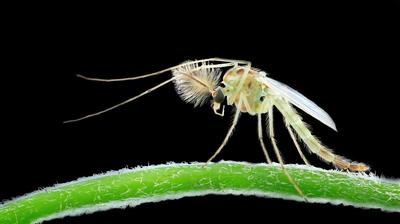No-see-ums
Description and Distribution

No-see-ums, also known as Ceratopogonidae, are defined as a family of small nematocerous flies, usually less than 3 or 4 mm in length. They are closely related to the Chironomidae, the non-biting midges, but differ from them in the presence of biting mouthparts in the female, the wing venation, and by the short forelegs. They are best known as ′biting midges′, but are also called ′sandflies′, ′punkies′ or simply ′biting gnats′. Roughly 5000 species in 60 or more genera have been described. They can be found worldwide, with the exception of the Arctic and Antarctic. [1] The distribution of species in the genus Culicoides is worldwide; 47 species are known to occur in Florida. Species belonging to the genus Leptoconops occur in the tropics, sub-tropics, the Caribbean, and some coastal areas of southeast Florida.
The natural habitats of biting midges vary by species. Areas with substantial salt marsh habitat are major producers of many biting midge species, while some species prefer areas that possess highly organic soil that is wet but not underwater, such as those found with high manure loads in swine-, sheep-, and cattle farming. These insects do not establish inside homes, apartments, or inside humans or other animals. [2]
Life cycle
![Biting midge life cycle. (Illustration by: Scott Charlesworth, Purdue University, based in part on Pechuman, L.L. and H.J. Teskey, 1981, IN: Manual of Nearctic Diptera, Volume 1)[3]](/images/3/3b/Lifecycle_biting_midges_500px.png)
The eggs are approximately 0.25 mm long. They are white when first laid, but later turn brown or black. The eggs are laid on moist soil and cannot withstand drying out. Some species can lay up to 450 eggs per batch and as many as seven batches in a lifespan. Eggs typically hatch within two to ten days of being laid, the hatch time being dependent on the species and environmental temperatures.
Larvae develop through four instars; the first instar larvae possess a functional spine-bearing proleg. Pupal color can be pale yellow, light brown, or dark brown. They are 2 to 5 mm in length with an unsegmented cephalothorax that has a pair of respiratory horns that may bear spines or wrinkles. During this stage, the insects possess a spiny integument which can be used to identify the fly to species level. [2]
The adult no-see-ums are gray and less than 1/8-inch long. The two wings possess dense hairs and pigmentation patterns. The wing patterns are used by biologists to identify and differentiate species. The large compound eyes are more or less contiguous above the bases of the 15-segmented antennae. The pedicle of the males' antennae contains the Johnston's organ. The mouthparts are well-developed with cutting teeth on elongated mandibles in the proboscis, adapted for blood-sucking in females, but not in males. The thorax extends slightly over the head, and the abdomen is nine-segmented and tapered at the end. [2]
Diet
No-see-ums are mostly predatory, although some are also collectors, gatherers, and scrapers. The predatory species feed on a range of macroinvertebrates, such as roundworms. The species that are collectors and gatherers tend to feed on algae, fungi, and decomposing organic material from plants, soil, bacteria, and feces. Adult no-see-ums feed on flower nectar, and females also need blood from insects, reptiles, or mammals to reproduce.[4]
See also
References
[1] Boorman, J. (1993). Biting midges (Ceratopogonidae). In: Lane, R.P., Crosskey, R.W. (eds) Medical Insects and Arachnids. Springer, Dordrecht. https://doi.org/10.1007/978-94-011-1554-4_7
[2] Connelly, C. R. (2013). Biting midges, no-see-ums Culicoides spp. (Insecta: Diptera: Ceratopogonidae). EDIS, 2013(5). doi:10.32473/edis-in626-2013
[3] Purdue University Extension. (n.d.). Biting Midges (No-see-ums). Purdue University. Retrieved May 2, 2025, from https://extension.entm.purdue.edu/publichealth/insects/bitingmidge.html
[4] EcoSpark. (n.d.). No-see-um. Retrieved May 2, 2025, from https://www.ecospark.ca/no-see-um
[5] “Acari.” Acari - Entomologists' Glossary - Amateur Entomologists' Society (AES), www.amentsoc.org/insects/glossary/terms/acari.
[6] Wilson, Nixon A. “Acarid.” Encyclopædia Britannica, Encyclopædia Britannica, Inc., 27 Dec. 2017, www.britannica.com/animal/acarid.
[7] NCSU Veterinary Parasitology, parasitology.cvm.ncsu.edu/vmp930/keys/mites/miteterms.html.
[8] Gulvik, M. "Mites (Acari) as indicators of soil biodiversity and land use monitoring: a review." Polish Journal of Ecology 55.3 (2007): 415.